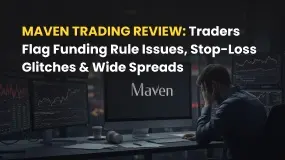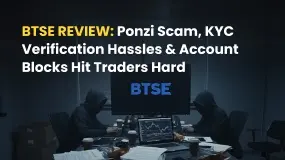简体中文
繁體中文
English
Pусский
日本語
ภาษาไทย
Tiếng Việt
Bahasa Indonesia
Español
हिन्दी
Filippiiniläinen
Français
Deutsch
Português
Türkçe
한국어
العربية
Learn This & Never Blow An Account Ever Again!
Abstract:The projected returns on a particular investment are weighed against the risk of loss using a mathematical formula known as the risk-reward ratio. Many traders may think that they have fully understood this concept but today’s article could shine a different light on this risk-reward concept like never before. Keep reading to learn more!

In the world of trading, the concept of risk and reward holds paramount importance, even more so than market analysis, as it determines the longevity and profitability of a trader's journey. Understanding the fundamental rule of the market, calculating risk per trade, and leveraging risk-to-reward ratios are crucial aspects that differentiate traders from mere gamblers, ultimately paving the way for consistent gains and avoiding catastrophic losses.
Before delving into the specifics of risk and reward, it is crucial to remember the fundamental rule of the market: “Each moment in the market is unique,” as emphasized in Mark Douglas's influential book, “Trading in the Zone.” Regardless of one's analytical prowess, the possibility of being wrong and losing trades always exists. Therefore, implementing proper risk management strategies is essential.

To begin, risk per trade must be calculated. Thinking in terms of percentages, rather than dollar amounts, in relation to the total account balance is crucial. Let's consider an example for clarity. Suppose you have a $1,000 trading account and decide to risk 3% per trade, which amounts to $30. If you enter a trade with a 30-pip stop loss and a 90-pip profit target (a 1:3 risk-to-reward ratio), calculating the appropriate lot size is crucial. With the allocated risk of $30, a lot size of 0.1 (where each pip is valued at $10) aligns with your risk management strategy. If the trade is successful, you stand to make $90.
The power of risk-to-reward ratios becomes even more evident when applied to different account sizes. Imagine you have a $100 trading account and wish to risk the same 3% per trade ($30). In this scenario, you opt for a tight 3-pip stop loss. As the stop loss is smaller, you can increase your lot size to 1. With a 90-pip profit target, the potential gain becomes a remarkable $900. This exemplifies the significance of aligning risk and reward ratios in pursuit of higher gains.
While the concept of calculating risk per trade may be understood by many traders, the key lies in realizing that the percentage risk remains fixed regardless of the stop loss distance. By implementing this approach consistently and seeking trades with favourable risk-to-reward ratios, traders can witness substantial account growth and achieve their financial goals.
In conclusion, successful trading revolves around the art of risk management and understanding the relationship between risk and reward. By calculating risk per trade, adhering to a predetermined risk percentage, and identifying favourable risk-to-reward ratios, traders can navigate the markets with confidence, ensuring their long-term survival and unlocking the potential for significant gains. Embrace the principles of risk management, and watch your trading journey transcend from one of uncertainty to one of consistent profitability.

Disclaimer:
The views in this article only represent the author's personal views, and do not constitute investment advice on this platform. This platform does not guarantee the accuracy, completeness and timeliness of the information in the article, and will not be liable for any loss caused by the use of or reliance on the information in the article.
Read more

Maven Trading Review: Traders Flag Funding Rule Issues, Stop-Loss Glitches & Wide Spreads
Are you facing funding issues with Maven Trading, a UK-based prop trading firm? Do you find Mavin trading rules concerning stop-loss and other aspects strange and loss-making? Does the funding program access come with higher spreads? Does the trading data offered on the Maven Trading login differ from what’s available on the popular TradingView platform? These are some specific issues concerning traders at Maven Trading. Upset by these untoward financial incidents, some traders shared complaints while sharing the Maven Trading Review. We have shared some of their complaints in this article. Take a look.

BTSE Review: Ponzi Scam, KYC Verification Hassles & Account Blocks Hit Traders Hard
Have you lost your capital with BTSE’s Ponzi scam? Did the forex broker onboard you by promising no KYC verification on both deposits and withdrawals, only to be proven wrong in real time? Have you been facing account blocks by the Virgin Islands-based forex broker? These complaints have become usual with traders at BTSE Exchange. In this BTSE review article, we have shared some of these complaints for you to look at. Read on!

Amillex Global Secures ASIC Licence for Expansion
Amillex Global gains ASIC AFSL licence, boosting FX and CFDs credibility. Expansion targets Asia, Australia, and institutional trading growth.

Inzo Broker Review 2025: Is It Legit or a High-Risk Gamble?
When you ask, "Is inzo broker legit?" you want a clear, straight answer before putting your money at risk. The truth about Inzo Broker is complicated. Finding out if it's legitimate means looking carefully at its rules, trading setup, and most importantly, the real experiences of traders who have used it. The broker shows a mixed picture - it has official paperwork from an offshore regulator, but it also has many user warnings about how it operates. This review gives you a fair and fact-based investigation. We will break down all the information we can find, from company records to serious user complaints, so you can make your own clear decision.
WikiFX Broker
Latest News
Is Fyntura a Regulated Broker? A Complete 2025 Broker Review
Zetradex Exposed: Withdrawal Denials, Account Freeze & Bonus Issues Hurt Traders
Is Forex Zone Trading Regulated and Licensed?
PINAKINE Broker India Review 2025: A Complete Guide to Safety and Services
Exness Restricted Countries List 2025 Explained
Is Uniglobe Markets Legit? A 2025 Simple Guide to Its Safety, Services, and User Warnings
Is Inzo Broker Safe or a Scam? An Evidence-Based Analysis for Traders
WikiEXPO Dubai 2025 “Welcome Party” Kicks Off Tonight!
He Trusted a WhatsApp Group and Lost RM659,000
Moomoo Singapore Opens Investor Boutiques to Strengthen Community
Currency Calculator



